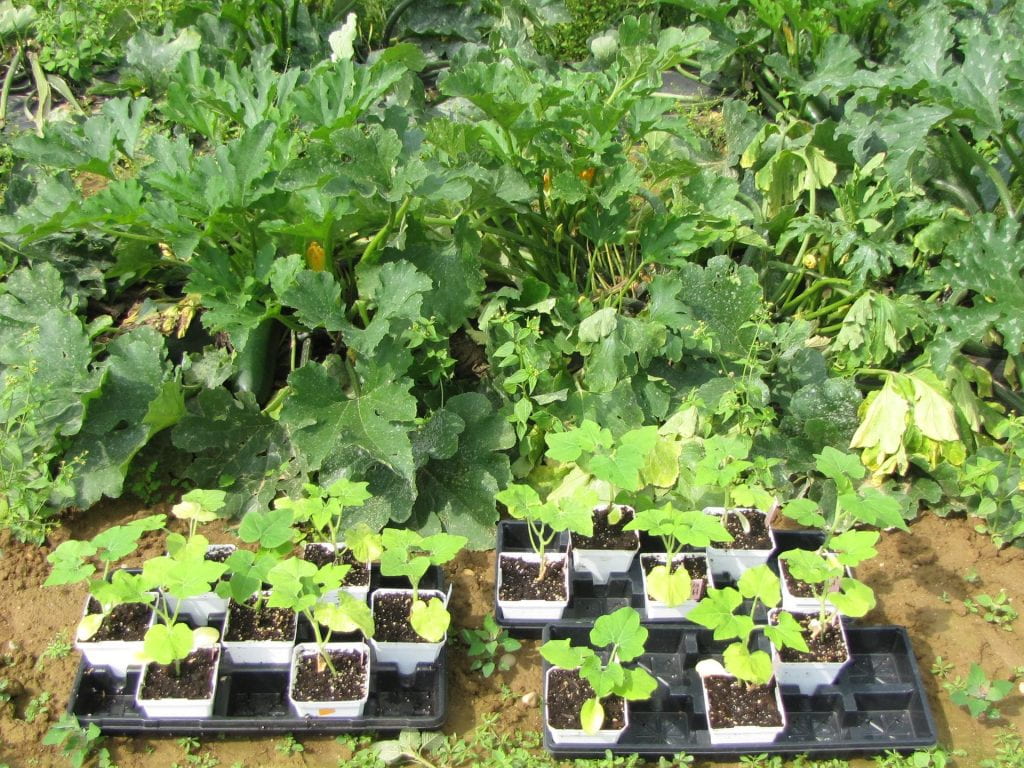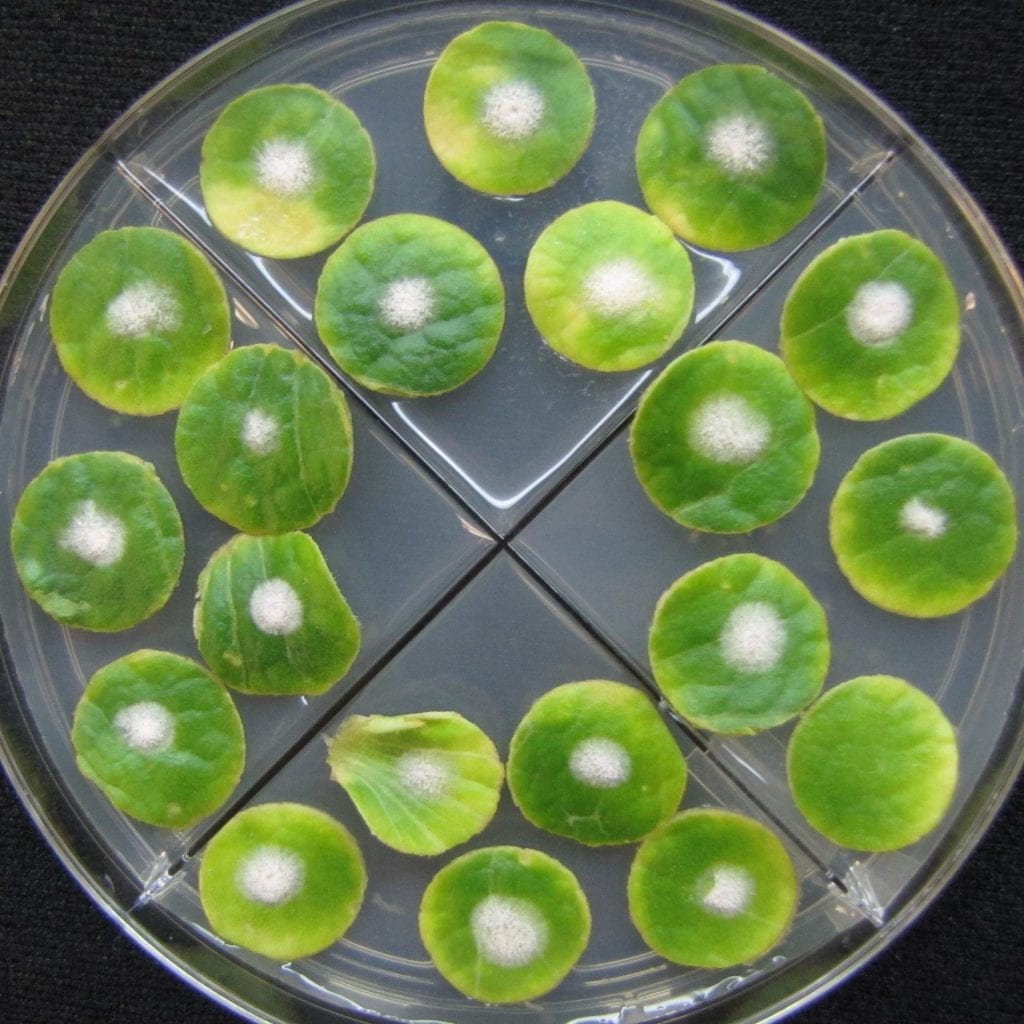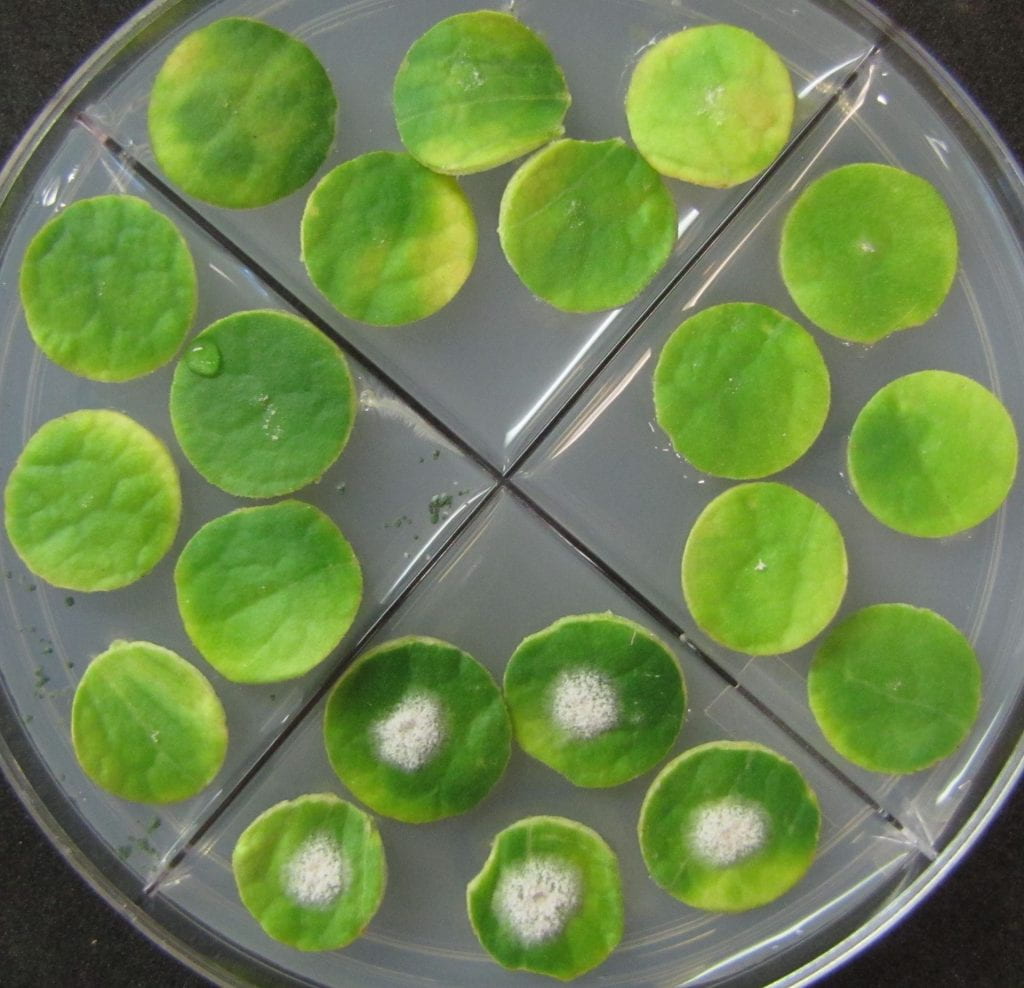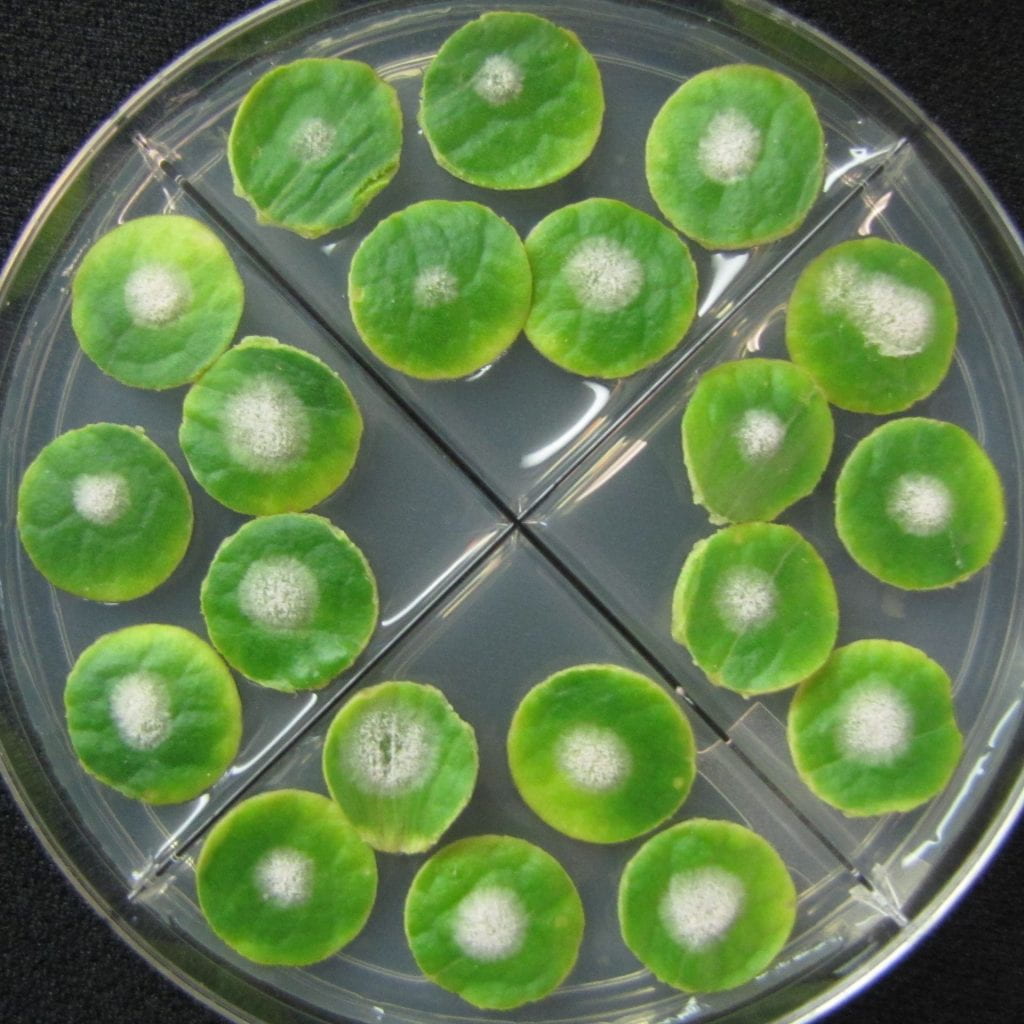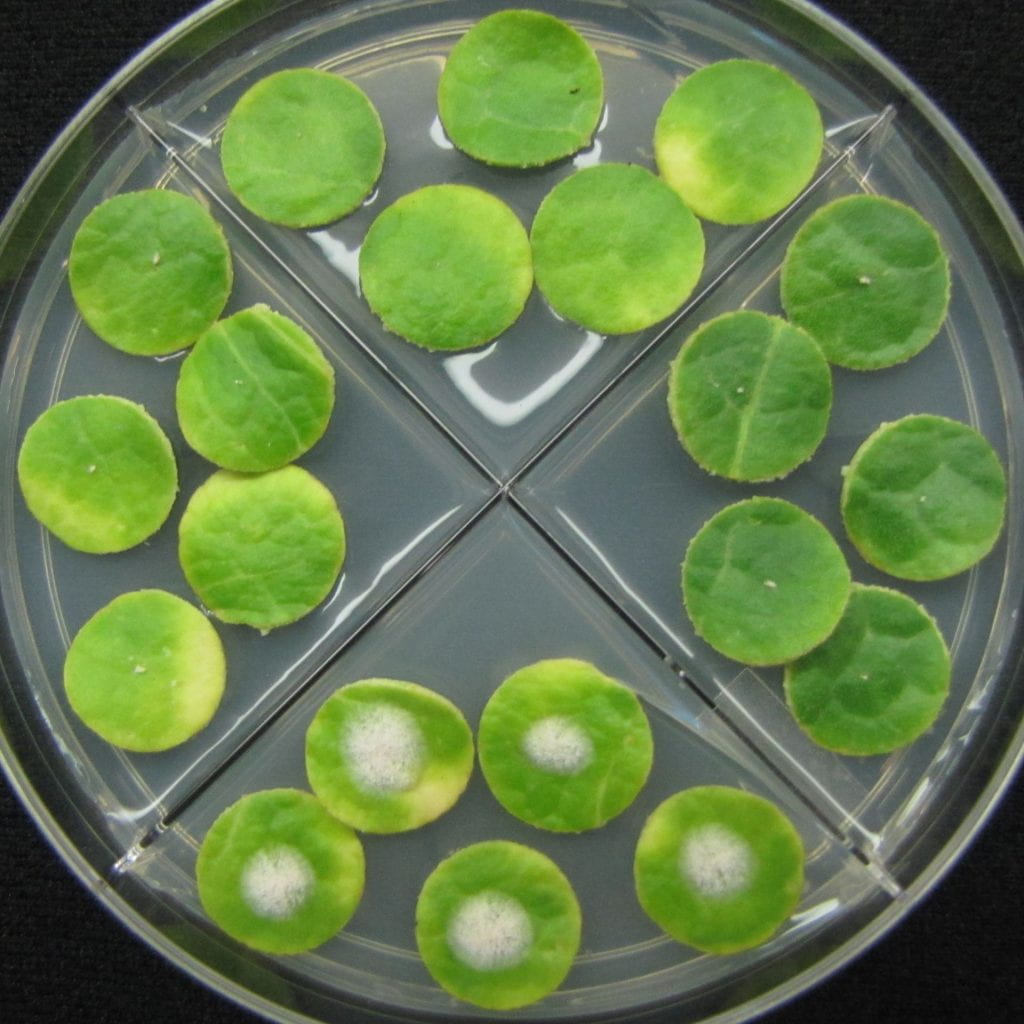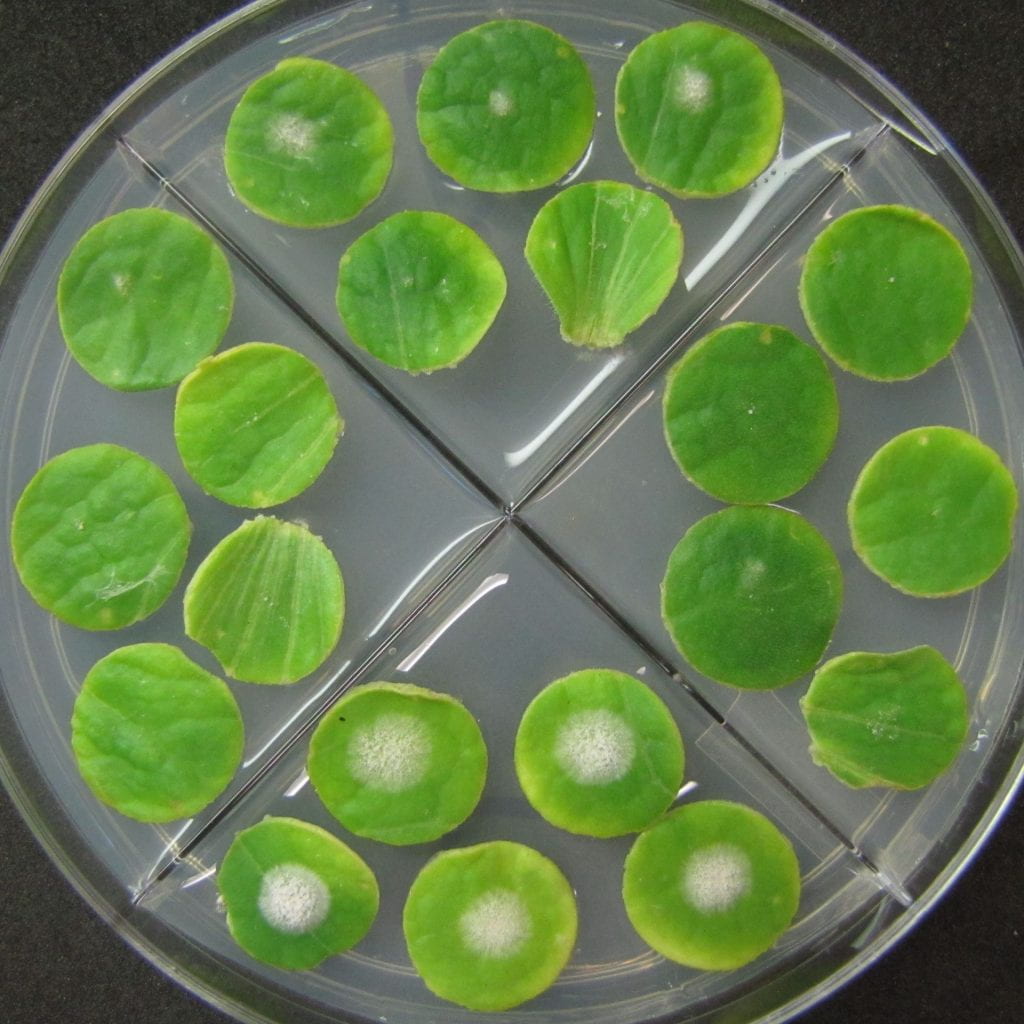Jump down to Recommendations for managing cucurbit powdery mildew in 2022.
Current knowledge about labeled fungicides and their efficacy for managing powdery mildew in cucurbit crops is essential for developing an effective fungicide program. Fungicides and resistant varieties are the primary management practices for this common disease. Fungicides are most important because disease resistant varieties typically do not suppress powdery mildew sufficiently (except for cucumber) to be used alone (without fungicide applications) to prevent powdery mildew causing reduction in yield or fruit quality, and an integrated program with both tools is recommended to manage selection of pathogen strains able to overcome either one. Leaves affected by powdery mildew die prematurely which results in fewer fruit and/or fruit of low quality (prone to sunscald, poor flavor, poor storability). Fungicide is needed on the lower surface of leaves where the pathogen develops best, which is best achieved with mobile fungicides able to move through leaves. Because these fungicides have targeted activity, they are prone to resistance development. The powdery mildew pathogen has a long history of evolving, in particular developing resistance to fungicides.
Every year research is conducted at the Long Island Horticultural Research and Extension Center (LIHREC) to obtain current information about fungicide efficacy and fungicide resistance in the pathogen in order to be able to develop sound fungicide recommendations. In addition to occurrence of resistant pathogen isolates impacting efficacy, there are inherent differences in efficacy among fungicides, most notably among products in the same FRAC group. Resistance has been documented to fungicides in FRAC groups 1, 3, 7, 11, 13, and U6 through previous research conducted at LIHREC.
Among the most important findings in 2021 was documenting the impact of fungicides applied to a crop on occurrence of resistance. Isolates were collected from 13 farms in western NY, eastern NY, and Long Island. Isolates were again detected with multi-fungicide resistance, being resistant to 2-4 different chemistries: Endura (FRAC group 7), Quintec (13), and Torino (U6), plus Flint (11) which only some isolates were tested for.
Fungicide evaluation was conducted with pumpkin in 2021 at LIHREC as in previous years. Focus was on evaluating biopesticides tested alone (experiment 1) and in programs with conventional fungicides (experiment 2). Treatments were applied weekly with a tractor-sprayer starting on 27 July for the biopesticide treatments, at which time powdery mildew was found on only 1 of the 720 leaves examined (0.14%), which was below the IPM action threshold for initiating fungicide applications of 1 out of 50 old leaves with symptoms (2%). Conventional fungicides were applied starting week 2. The fifth application scheduled for 24 Aug was delayed by 2 days because of extensive rainfall (2.6 in.) with Hurricane Henri on 22-23 Aug. The last application was applied early due to rain forecast with remnants of Hurricane Ida starting late on 1 Sept (3.3 in. total). It is possible efficacy of treatments was affected by the impact of these storms on application timing, product residues, and/or disease development.
The biopesticides when tested alone controlled powdery mildew on upper leaf surfaces but not lower surfaces which documents that they have contact activity. Products tested were Howler, Theia, Howler applied in alternation with Theia, MBI-121 (combination of Regalia and Stargus), Tril-21, Aviv, and Aviv + Timorex ACT. Kocide 3000-O, the organic copper treatment included for comparison, was numerically but not statistically more effective than most biopesticide treatments. All are now allowed in organic production (OMRI-listed) or are expected to be. Theia, Tril-21, and MBI-121 are not commercially available yet.
The second experiment documented that powdery mildew can be effectively managed with fungicide programs consisting of biopesticides applied in alternation with conventional fungicides thereby decreasing by half the number of applications of conventional fungicides; however, equally effective control was achieved with the two parallel treatments with just the three applications of the conventional fungicides made on the same dates, documenting the excellent efficacy of the two conventional fungicides used, Proline and Vivando. Two-week interval between applications of other conventional fungicides may not provide as good control. Programs being tested in 2022 consist of 1-2 applications of a biopesticide before powdery mildew is at threshold, followed by 3 applications of conventional fungicides, and then 3 applications of the biopesticide. Maintaining excellent control during the period that conventional fungicides with resistance risk are applied is a resistance management tactic.
This experiment additionally confirmed results from a similar experiment conducted in 2020 that also documented that Cevya, a new DMI (FRAC 3) fungicide, is not as effective as anticipated based on its chemistry. Cevya was the least effective conventional fungicide treatment for powdery mildew on lower leaf surfaces, providing 67% control compared to 99% control with weekly alternation of Proline and Vivando and 89% control with 14-day alternation of Proline and Vivando.
Seedling fungicide sensitivity bioassay was used to detect fungicide resistance in cucurbit powdery mildew pathogen populations on Long Island in 2021. The bioassay entails treating potted seedlings at about the 3-leaf stage with different fungicide doses, putting them in field locations next to plants naturally affected by powdery mildew for a day, keeping them in a greenhouse until symptoms develop, then each leaf is assessed for severity based on percent coverage with visible symptoms. Severity on treated leaves is compared to untreated leaves. The bioassay was conducted twice in commercial and research plantings.
Bioassay 1 seedlings were treated on 10 Aug and put in a research and a commercial spring planting of zucchini that had not been treated with targeted fungicides for powdery mildew. Very few powdery mildew symptoms developed on seedlings, including on the water-treated control seedlings, although symptoms were common on the plants at the locations used, likely because the pathogen was suppressed by a period of hot weather during the first week after infection when temperatures in the greenhouse exceeded 100°F during the day. Despite this, evidence was obtained for presence of resistance in both populations to Topsin M (FRAC 1), Flint Extra (11), and Endura (7) and to a less degree to Torino (U6). Sensitivity was good to Quintec (13) and Rally (3).
Bioassay 2 seedlings were treated on 13 Sep and put in commercial and research plantings that had been treated with different fungicides for powdery mildew. Topsin M, Flint Extra, and Endura were ineffective indicating a high frequency of resistance to these chemistries. Resistance to these fungicides have been detected commonly in the past. Torino and Quintec exhibited good efficacy at highest and below label rates (78-99% control). Resistance to these fungicides have been detected in the past associated with control failure. Resistance to Torino was detected in the 2020 bioassay. These fungicides were not applied at any of the locations used. Rally and Vivando (50) were very effective (96-100% control) at full and below label rates, suggesting that applying Vivando and another FRAC 3 fungicide (Proline) at these locations did not result in selection for resistance to these chemistries. Vivando at all tested rates was more effective than Torino applied at labeled field rate.
These results document resistance remains common for FRAC code 1 and 11 fungicides, and also for the FRAC 7 active ingredient (AI) that is in Endura and Pristine, thus they are not recommended. Luna fungicides (not permitted used on LI), which contain fluopyram, a FRAC 7 AI that binds differently to the target site in fungal pathogens than boscalid, continue to be effective documenting that resistance impacting control has not been detected yet to this chemistry. Vivando (50) and Rally (3) were also highly effective. Other FRAC 3 (DMI) fungicides (Proline and Procure) are recommended because they have exhibited better control in season-long evaluations. While Quintec and Torino exhibited good efficacy in 2021 in the seedling bioassays, limited use is recommended due to resistance being detected in the past on LI and being detected in upstate NY in 2021.
Results from Bioassay 2 show good agreement with results obtained by testing isolates collected from these locations (next section).
Below: Fungicide-treated seedlings in zucchini (first image) and pumpkin (second) crops with powdery mildew to determine what fungicides the pathogen there is resistant to.
Leaf disk bioassay was used to detect resistance in cucurbit powdery mildew pathogen isolates (i.e. individuals) collected at the end of the season from a research planting at LIHREC and commercial crops on Long Island and in upstate New York. The isolates were maintained on cotyledons in petri dishes and tested on disks cut from fungicide-treated cotyledons in the laboratory. There were 32 isolates from the research planting and 90 isolates from commercial plantings: 3 farms in western NY, 9 in eastern NY, and 1 on Long Island. The table has percent of the isolates determined to be resistant to Torino (FRAC U6), Quintec (13), and Endura (7) at the 14 locations. The dose of these 3 fungicides applied to leaves used in the bioassay is the dose in a spray tank when the fungicides are applied at 50 gpa, thus isolates able to tolerate and grow on the treated disks are fully resistant to the fungicide.
Resistance to Endura (7) was detected in all plantings although there were no applications of this fungicide nor Pristine, which has the same active ingredient (boscalid), nor another cross resistant fungicide in this FRAC group (e.g. Merivon) to select for this resistance. These fungicides are not recommended because they will provide little to no control. 61% of isolates were resistant to Endura.
Resistance to Quintec (13) and to Torino (U6) were mostly detected in plantings where one of these fungicides was applied. This documents that using them during a growing season selects resistant isolates to a detectable degree that is expected to impact their efficacy. These fungicides were not used and resistance was not detected in four locations: WNY commercial crop 1 and 3, ENY commercial crop 1, and the research field at LIHREC. Resistance to Quintec was common (67, 71, and 100% of isolates) in the three locations where this fungicide was applied twice, despite the fact its use for all three plantings was in a recommended resistant management program consisting of an alternation among targeted fungicides all tank mixed with contact fungicides: ENY commercial crop 3, 5, and 6. Notably, ENY commercial crop 3 where all isolates were resistant to Quintec is only a few miles from ENY commercial crops 1 and 2 where resistance was not detected. However, resistance to Quintec was not detected in ENY commercial crop 4 where it was applied once. Additionally, resistance was detected in four locations where these fungicides were not applied: WNY commercial crop 2, ENY commercial crop 7 and 8, and the Long Island commercial crop. Selection for resistance to Quintec perhaps occurred in other nearby crops treated with this fungicide. Detection of resistance to Quintec in crops where the fungicide was not used indicates this resistance is somewhat common, albeit not as common as resistance to Endura, and that resistant isolates are able to compete with sensitive isolates. Resistance to Torino was detected in 1 of the 2 locations where it was applied (ENY commercial crop 9) and 5 locations where this fungicide was not used. This finding partly reflects the fact that 15 of the 22 isolates (68%) that were resistant to Torino were also resistant to Quintec, thus applying Quintec would have selected these isolates with resistance to both fungicides.
In the research field at LIHREC in 2021, while many isolates (61%) were found to be resistant to Endura, resistance to Torino and Quintec was not detected as it had been in previous years.
Resistance to QoI fungicides (FRAC 11) was detected in all 23 isolates tested. QoI resistance has been common for many years indicating this trait is remaining in the pathogen population although these fungicides have not been recommended for many years. QoI resistance was first detected in NY in 2002.
Multi-fungicide resistant isolates were detected in 2021, but not at as high a percentage as in 2018 – 2020. Resistance to Endura, Quintec, and Torino was detected in 35%, 38%, and 19% of the isolates those years, respectively, versus 11% of the 122 isolates from commercial and research plantings collected in 2021. Likely all isolates were also resistant to QoI fungicides.
Isolates were also tested for their sensitivity to Vivando, FRAC 7 ingredient in Luna fungicides, and the DMI (FRAC 3) fungicides Rally, Procure, and Proline. The main goal was to determine if there were pathogen isolates less sensitive to these chemistries than isolates tested in the past.
Vivando at 50 ppm was tolerated by more isolates than in the past (31%). Field dose is 600 ppm when Vivando is applied at 50 gpa, so these tolerant isolates are not a concern for control, but there is concern the pathogen may become more insensitive and eventually resistant. Interestingly, isolates tolerating Vivando at 50 ppm were not found more commonly in plantings treated with Vivando than those that were not (23% versus 43% of isolates). 20 isolates that tolerated 50 ppm were sensitive to 150 ppm.
The Luna fungicide active ingredient that is in all formulations, fluopyram, at 50 ppm was tolerated by 86% of the isolates that were resistant to Endura. Cross resistance among these FRAC 7 fungicides was not expected because these fungicides bind differently in the pathogen. 60% of isolates from commercial crops and 55% of all isolates tolerated 50 ppm fluopyram. 150 ppm fluopyram was tolerated by 2 of the 32 isolates tested at this dose, which were all isolates able to tolerate 50 ppm.
The DMI (FRAC 3) fungicide Rally at 40 ppm was tolerated by 33% of isolates with most exhibiting less than 50% growth compared to the isolate’s growth on untreated disks; 49% of isolates from plantings treated with a DMI fungicide. 2 isolates tolerated Rally at 100 ppm. Interestingly they were from a planting where DMR fungicides were not applied. Field dose is 150 – 300 ppm when Rally is applied at 2.5 – 5 oz/A at 50 gpa. 17 of 28 isolates tolerating 40 ppm Rally were tested and found able to grow on leaf disks treated with 80 ppm Rally, Procure, and/or Proline, but only 8 exhibited growth not reduced by at least 50% compared to their growth on untreated disks. Thus, while isolates are being detected with reduced sensitivity to DMI fungicides, they are expected to be controlled by these fungicides.
Below: Bioassay plates with leaf disks treated with 50 ppm Torino (left section of plate), 200 ppm Quintec (top), and 50 ppm Vivando (right). Powdery mildew pathogen isolate tested in the first plate is resistant to Torino and Quintec because the concentration applied to the disks is that applied to crops when these fungicides are applied at highest label rate and 50 gpa. The field application concentration for Vivando is 606 ppm when applied at 50 gpa, thus isolates like this one able to grow on leaf disks treated with 50 ppm Vivando are exhibiting reduced sensitivity compared to other isolates (like the one in the second plate) but not resistance to Vivando. In contrast, the isolate in the second plate is sensitive to these fungicides because it was only able to grow on nontreated leaf disks (bottom).
Below: Bioassay plates with leaf disks treated with 500 ppm Endura (left section of plate), 50 ppm Luna Privilege (top), and 40 ppm Rally (right). Powdery mildew pathogen isolate tested in the first plate was able to grow well on all fungicide-treated disks while isolate in second plate was only able to grow on nontreated leaf disks (bottom). The first isolate is exhibiting resistance to Endura because the concentration applied to the disks is that applied to crops when Endura is applied at highest label rate and 50 gpa. The other fungicides were applied at below label rates to test for reduced sensitivity; resistance to these has not been documented yet.
Below: Bioassay plate with leaf disks treated with 150 ppm Vivando (left section of plate), 100 ppm Rally (top), and 150 ppm Luna Privilege (right). This isolate exhibited reduced sensitivity to these fungicides: it was able to grow on leaf disks treated with 50 ppm Vivando (it is in first plate above), 40 ppm Rally, and 50 ppm Luna Privilege. This plate documents the isolate is sensitive to the higher doses applied to these leaves and thus it is expected to be controlled by these fungicides applied at label rates (which are higher than rates in this bioassay) under field conditions.
Important information about fungicide resistance with implications for managing cucurbit powdery mildew were obtained through this research in 2021 and previous years.
- Frequency of resistant isolates in a pathogen population can increase substantially during one growing season. This has been documented in research fields where there were untreated plots and plots treated weekly with single fungicides at risk for resistance.
- Resistant isolates have also been detected in research plantings and commercial crops where fungicides were applied in an alternation program as recommended, as well as in plantings not treated with any fungicides at risk for resistance which indicates resistant isolates are fit and able to compete with sensitive isolates.
- Several isolates have been documented with resistance to multiple fungicides: Endura, Quintec, Torino, and QoI fungicides. Isolates with this resistance have been detected since 2017. They came from research plots treated with single fungicides, alternation programs (including commercial crops), and occasionally from untreated plots. This represents a huge challenge to effectively managing fungicide resistance. An assumption behind the recommendation to alternate among chemistries is that it will be difficult for the pathogen to develop resistance to multiple chemistries and such isolates will likely be less fit and not able to compete well with sensitive isolates in the absence of fungicides.
Recommendations for managing cucurbit powdery mildew in 2022:
- Select resistant varieties.
- Inspect crops routinely for symptoms beginning at the start of fruit development. The action threshold for starting applications is one leaf with symptoms out of 50 older leaves examined. Examine both surfaces of leaves. Starting treatment after this point will compromise control and promotes resistance development. Powdery mildew usually begins to develop around the start of fruit production. Contact conventional fungicides and biopesticides applied before detection may slow initial development.
- When powdery mildew is present, apply targeted fungicides weekly with contact fungicides (sulfur, chlorothalonil, and oil are more effective than copper; biopesticides are also a good choice) and alternate amongst available chemistry based on FRAC Group code. It is prudent to decide now what products to use each week to have a plan in place ready to implement. Use highest label rates to control moderately resistant isolates if present.
- Assess control achieved on the underside of leaves toward the end of the season when there is still a good canopy.
Vivando can be applied up to 3 times with no more than 2 sequential applications. It is a good choice for the last application considering the long residual activity observed in the 2018 fungicide evaluation; it is also recommended used at other times during the season.
DMI fungicides (FRAC 3) are also a good choice in the program, in particular for the first application. Proline is the most effective. It is also labeled for Fusarium. Crop limit is 2 applications. Procure is also very effective. It can be applied 3 times; 4 times to direct-seeded crops when the intermediate rate is used. Aprovia Top (3 and 7) and Inspire Super (3 and 9) are additional options; they contain the same FRAC 3 ingredient (difenoconazole).
Quintec, Torino, Endura, and QoI fungicides are not recommended.
Example recommended alternations of targeted fungicides:
- 6 applications: Proline, Vivando, Proline, Vivando, Procure, Vivando
- 6 applications: Procure, Vivando, Procure, Vivando, Procure, Vivando
- 6 applications: Proline, Proline, Vivando, Vivando, Procure, Vivando
- 8 applications: Proline, Procure, Vivando, Proline, Procure, Vivando, Procure, Vivando
Additional information for growers in upstate New York: Rhyme, Miravis Prime, and Luna Experience are additional FRAC 3 fungicides that can be used. Luna Experience has the advantage of having an additional active ingredient (7). Gatten (U13) is a new fungicide registered in NY in 2020 that is also not permitted used on LI. It can be applied twice.
Additional information for growers elsewhere: Gatten can be applied five times.
Additional information about managing cucurbit powdery mildew and table of fungicides are available on the Cornell Vegetables Cucurbit Powdery Mildew webpage.
More information/prepared by:
Margaret Tuttle McGrath
Associate Professor
Long Island Horticultural Research and Extension Center (LIHREC)
Plant Pathology and Plant-Microbe Biology Section
School of Integrative Plant Science
College of Agriculture and Life Sciences
Cornell University
mtm3@cornell.edu
Please Note: The specific directions on fungicide labels must be adhered to — they supersede these recommendations, if there is a conflict. Check labels for use restrictions. Any reference to commercial products, trade or brand names is for information only; no endorsement is intended.



